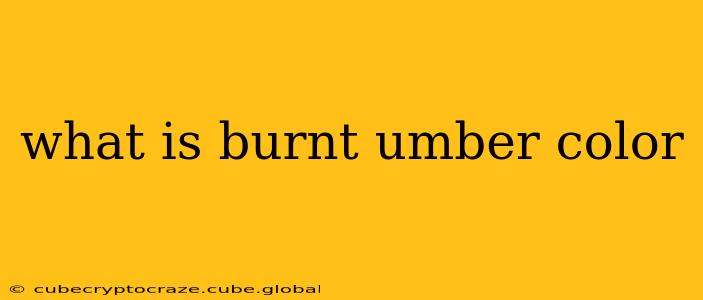Burnt umber is a deep, rich brown pigment with reddish-brown undertones. Its name hints at its creation: it's a naturally occurring earth pigment, umber, that has been heated (burnt) to achieve its characteristic dark, warm hue. This process alters the chemical composition, resulting in a color that's significantly darker and warmer than raw umber. Understanding its unique qualities, uses, and variations helps appreciate its versatile role in art and design.
What Does Burnt Umber Look Like?
Burnt umber's appearance is best described as a dark reddish-brown. It's not a simple, flat brown; instead, it possesses complexity, with hints of red and sometimes even a touch of orange depending on the specific pigment and the manufacturing process. The exact shade can vary subtly based on the source of the umber and the intensity of the burning process. Think of the color of rich, dark soil after a rain, or the shade of a well-worn, antique wooden piece.
What is the Difference Between Raw Umber and Burnt Umber?
The key difference lies in the heat treatment. Raw umber is a naturally occurring earth pigment containing iron oxides and manganese oxides, resulting in a yellowish-brown color. Burnt umber, on the other hand, is raw umber that has been heated, causing a chemical change that deepens its color to a darker, reddish-brown. This heating process also alters the pigment's translucency, making burnt umber slightly more opaque than its raw counterpart.
What is Burnt Umber Used For?
Burnt umber's versatility makes it a staple in many creative fields:
-
Painting: Both oil and watercolor painters frequently use burnt umber for underpainting, creating a base layer to establish values and tones before applying other colors. It's also excellent for shading, creating depth, and adding rich brown tones to landscapes, portraits, and still lifes. Its ability to blend seamlessly with other colors makes it invaluable for creating nuanced effects.
-
Drawing: Burnt umber is a popular choice for sketching and drawing, offering a warm, earthy tone that’s easy to blend and layer.
-
Interior Design: Burnt umber's earthy tones translate well into interior design. It can be used in paints, fabrics, and furniture to create a warm, inviting atmosphere. Think of sophisticated, rustic designs.
-
Cosmetics: While less common than other pigments, burnt umber can sometimes be found in makeup products, lending a natural, earth-toned color.
What are the Different Shades of Burnt Umber?
While the core characteristic remains a deep reddish-brown, subtle variations exist depending on the source material and the burning process. Some burnt umber pigments may lean more towards a reddish-brown, while others might exhibit slightly more orange or even a touch of purple undertones. These variations add to the richness and complexity of the color, allowing for nuanced choices in creative projects.
Is Burnt Umber Transparent or Opaque?
Burnt umber is generally considered to be relatively opaque, especially compared to raw umber. However, the degree of opacity can vary slightly depending on the specific pigment and the application method. Thin washes of burnt umber will show more transparency than thicker applications.
How Do I Use Burnt Umber in My Art?
Experimentation is key! Start by mixing it with other colors to explore its blending capabilities. It mixes beautifully with yellows to create warm browns and oranges, with blues to create muted greens and grays, and with reds to deepen and enrich the red tones. Use it as an underpainting, a shading color, or even a stand-alone color depending on the effect you want to achieve.
Burnt umber, with its rich history and versatile properties, remains a cherished pigment for artists and designers seeking to capture the warmth and depth of the earth in their creations.
